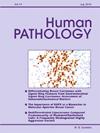Beta-2-microglobulin positive tumor cells and CD8 positive lymphocytes are associated with outcome in post-neoadjuvant colorectal cancer resections
IF 2.7
2区 医学
Q2 PATHOLOGY
引用次数: 0
Abstract
Locally advanced colorectal cancers are treated with neoadjuvant therapy (NAT), which has been shown to alter the characteristics of the tumor including size, lymph node yield, and histologic grade. We seek to interrogate the effect of NAT on the immune microenvironment. We compared 190 patients with colorectal adenocarcinoma treated with NAT with those without NAT (n = 926). We evaluated clinicopathologic and molecular factors and performed immunohistochemistry and quantification on tissue microarrays for HLA class I/II proteins, beta-2-microglobulin (B2M), CD8, CD163, LAG3, PD-L1, and FoxP3. Patients in the NAT group were younger (60.9 vs 67.9, p < 0.001) and more often male (59.5 vs. 47.9, p = 0.004) than those in the non-NAT group. Tumors in the NAT group were smaller (3.5 vs 4.7 cm, p < 0.001), less often high grade (6.5% vs. 16.2%, p = 0.001), more frequently in the rectum (68.9% vs. 6.6%, p < 0.001) and associated with lower lymph node yields (p = 0.002); however, the incidence of extramural venous invasion, perineural invasion, and AJCC stage 3–4 disease were not different. Immune cells positive for CD8 (p = 0.011) were significantly lower in the NAT group. A high number of CD8+ cells and higher expression of B2M in tumor cells showed a significant survival benefit in both NAT and non-NAT group. NAT is associated with an immune-low tumor environment. CD8+ cells and tumor B2M expression may help identify a subset of immune high-tumors following NAT. This identification could aid in determining patients who may benefit from conservative management of colorectal carcinomas.

β -2微球蛋白阳性肿瘤细胞和CD8阳性淋巴细胞与结直肠癌新辅助切除后的预后相关。
局部晚期结直肠癌的治疗采用新辅助治疗(NAT),新辅助治疗已被证明可以改变肿瘤的特征,包括肿瘤大小、淋巴结肿大和组织学分级。我们试图探究NAT对免疫微环境的影响。我们比较了190例接受NAT治疗的结直肠癌患者和未接受NAT治疗的结直肠癌患者(n=926)。我们评估了临床病理和分子因素,并在组织芯片上对HLA I/II类蛋白、β -2-微球蛋白(B2M)、CD8、CD163、LAG3、PD-L1和FoxP3进行了免疫组织化学和定量分析。与非NAT组相比,NAT组患者更年轻(60.9 vs 67.9, p < 0.001),男性患者更多(59.5 vs 47.9, p = 0.004)。NAT组的肿瘤较小(3.5 vs 4.7 cm, p < 0.001),较少出现高级别肿瘤(6.5% vs. 16.2%, p = 0.001),更多出现在直肠(68.9% vs. 6.6%, p < 0.001),并伴有较低的淋巴结肿大(p = 0.002);然而,外静脉侵犯、神经周围侵犯和AJCC 3-4期疾病的发生率没有差异。NAT组CD8阳性的免疫细胞明显减少(p = 0.011)。在NAT组和非NAT组中,肿瘤细胞中CD8+细胞数量和B2M的高表达均显示出显著的生存益处。NAT与免疫低下的肿瘤环境有关。CD8+细胞和肿瘤B2M表达可能有助于识别NAT后的免疫高肿瘤亚群。这种识别有助于确定可能从结肠直肠癌保守治疗中获益的患者。
本文章由计算机程序翻译,如有差异,请以英文原文为准。
求助全文
约1分钟内获得全文
求助全文
来源期刊

Human pathology
医学-病理学
CiteScore
5.30
自引率
6.10%
发文量
206
审稿时长
21 days
期刊介绍:
Human Pathology is designed to bring information of clinicopathologic significance to human disease to the laboratory and clinical physician. It presents information drawn from morphologic and clinical laboratory studies with direct relevance to the understanding of human diseases. Papers published concern morphologic and clinicopathologic observations, reviews of diseases, analyses of problems in pathology, significant collections of case material and advances in concepts or techniques of value in the analysis and diagnosis of disease. Theoretical and experimental pathology and molecular biology pertinent to human disease are included. This critical journal is well illustrated with exceptional reproductions of photomicrographs and microscopic anatomy.
 求助内容:
求助内容: 应助结果提醒方式:
应助结果提醒方式:


